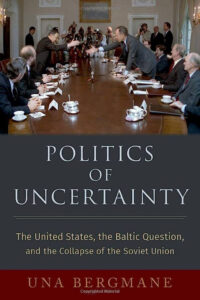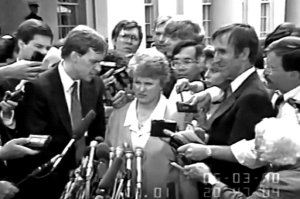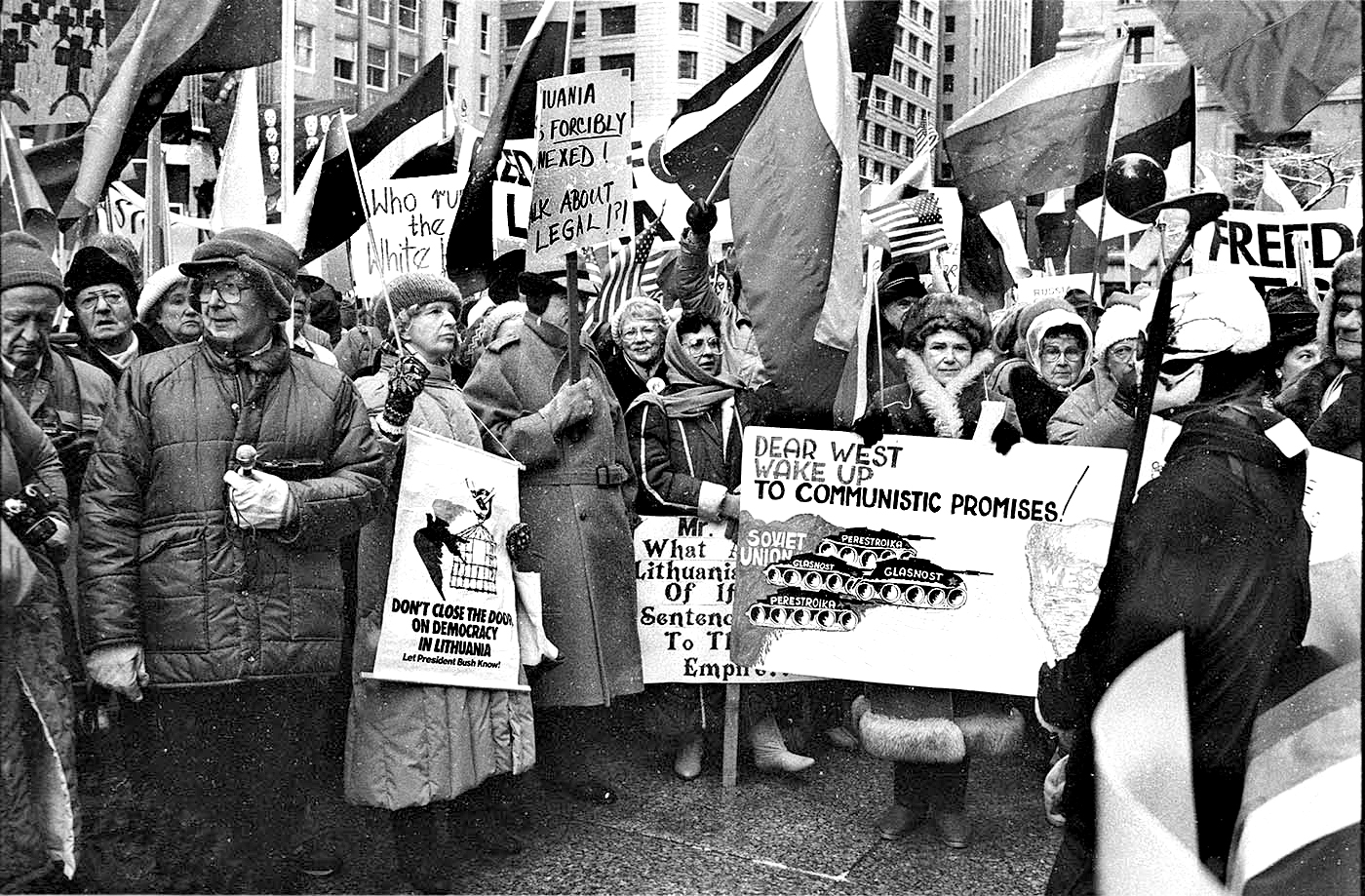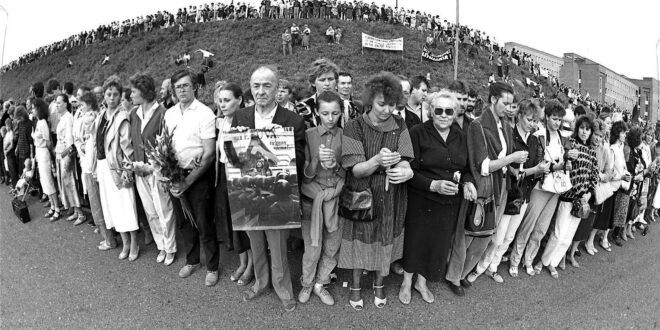Victor Nakas.
As Ronald Reagan was halfway through his second term in the White House, his vice president was making plans to succeed him. Unlike Reagan, who excelled at communicating with the public, George H. W. Bush was being faulted for a dearth of vision — the ability to communicate big ideas. Bush dismissed this criticism, dubbing it “the vision thing.” That phrase — and the perceived leadership deficit associated with it — became part of his persona.
Now comes a book by a Latvian scholar that explains how the leaders of the United States and the USSR lacked a coherent strategic plan and vision for dealing with the Baltic states as they embarked in 1989 on the quest to restore their independence. The author asserts that the two superpowers’ myopia mostly redounded to the benefit of the Baltic republics.
Politics of Uncertainty: The United States, the Baltic Question, and the Collapse of the Soviet Union by historian Una Bergmane focuses on the period 1989-1991. In the book’s Introduction, she lays out the central arguments in the pages that follow. “Between 1989 and 1991, Washington and its European allies moved from extreme prudence regarding the Baltic claims to unconditional support for their independence. However, this change was reluctant and driven much more by domestic pressures and last-minute decisions rather than by realpolitik calculations and long-term strategy.”

As for Gorbachev, he “had no plan of how to deal with center-republic relations in general and the Baltic situation in particular.” Not only did he and other Soviet leaders have no plan, they had “no time” and “no expertise” to contribute because Perestroika reforms were dominating their attention. While both superpowers grappled with uncertainty and a “whirlpool of change” caused by Perestroika, the Balts had “both a clear goal – independence – and relatively strong internal agreement of how to achieve it.” Their main challenge was “invisibility” on the international stage, by which she means that they tended to be ignored.
Though Bergmane never states this explicitly, her book has the effect of taking the elites in Moscow and Washington down a notch. Rather than being portrayed as wise, strategic decision-makers, they come across as harried leaders in reactive mode, dealing with the churn of events and not necessarily acquitting themselves well in the process. In previewing Chapter 3 on the “Lithuanian Crisis of 1990” (i.e., the March 11 Declaration of Independence and its aftermath) she says “the White House’s attempts to diffuse the crisis were often hesitant, chaotic, and to a considerable extent driven by congressional pressures and Baltic diaspora grievances.” Gorbachev and the Politburo are shown to be one step behind in dealing with Baltic leaders. As late as spring 1989, Gorbachev believed that in the Baltic states a “moderate” majority would prevail over “radicals.” In late 1989 Politburo meeting documents indicate that Soviet leaders understood the Balts were moving toward independence but were willing only to offer economic autonomy, which might have been enticing in 1988 but by then was “too little too late.”
Bergmane argues that most Western scholarship on the collapse of the USSR has focused on the elites in Moscow and Western capitals, and that other scholars, herself included, “have begun to look beyond [this] nexus.” Politics of Uncertainty does this “by studying the triangular relations among Moscow, the Baltic capitals and Washington and highlighting the interconnections between the domestic and external factors in the Soviet collapse.” Her success in explaining these triangular relations makes the book compelling.
The book benefits from the author’s simple, clear-eyed, and dispassionate analysis of the forces and personalities that shaped the events of 1989-1991. For those of a certain age who lived through those by turns exhilarating and nerve-racking events as participants or close observers, it may have been difficult to step back and see the big picture. She has no difficulty in doing so, perhaps because she was a only a child when Latvia regained its independence.
Bergmane says that after the watershed Baltic Way in August 1989 – millions of Baltic citizens linking hands from Tallinn in the north to Vilnius in the south – two factors drove the Bush administration to put the Baltic question on the agenda of its talks with the USSR: the longstanding U.S. policy of refusing to recognize the illegal incorporation of the Baltic states into the USSR and pressure from the U.S. Congress. She devotes considerable attention to congressional actions in support of Baltic independence. She also highlights the role of the Baltic diaspora and the Western press. But to my mind she understates the impact of the latter two in advancing the Baltic cause. She doesn’t consider the possibility that without five decades of consistent Baltic diaspora lobbying in Washington and at the state and municipal level, the non-recognition policy would likely either have been traded away years earlier by the United States to gain some concession from the Soviets or relegated to some dark, dusty corner of a State Department archive. Without Baltic-American pressure, the base of congressional support for Baltic statehood would have been narrow and shallow, unlikely to generate widespread support on Capitol Hill in 1989, when it mattered most. The diaspora was the sine qua non that breathed life into the non-recognition policy and habituated members of Congress to be supportive of the Baltic cause over many years.
Similarly, the role of the U.S. media in raising the visibility of the Baltic question was larger than the book suggests. The author concentrates her analysis on newspaper coverage. But electronic media – TV and radio – provided abundant coverage of the Baltic cause and arguably reached more people, more frequently, than print media did. To cite one example, when Lithuanian prime minister Kazimiera Prunskienė visited the White House on May 4, 1990, it was the lead story on all three major U.S. national TV network evening news broadcasts, which had a combined viewership of more than 20 million households.

One of Lithuania’s misfortunes of timing was that its March 11 Independence Declaration came three days before German reunification talks involving East and West Germany and the four Allied powers countries that had vanquished Nazi Germany. It was clear at the time to Lithuanian Americans that German reunification was a top priority for the Bush administration and that Lithuania was not. Bergmane goes a step further, arguing that the United States was not interested in using the German reunification talks to support democratization in Eastern Europe nor to expand its influence there.
Perhaps her most jarring insight is that, for the White House, non-use of force in the Baltics by the USSR was a more important goal – “a red line” – than Baltic independence itself. Soviet killings in the Baltic capitals “would complicate U.S.–Soviet relations at a time of crucial negotiations by reducing Bush’s maneuverability vis-a-vis domestic pressure groups.” After Lithuania agreed to suspend implementation of its declaration of independence in June 1990, “the White House started to lose interest in the Baltic problem.” Meanwhile, the situation the Baltic states found themselves in remained unfavorable. Their efforts to internationalize their quest for independence by securing ongoing Western involvement were unsuccessful and they were left to fend for themselves.
After the January 1991 killings in Vilnius and Riga, the ground started to shift. In contrast to spring 1990, she says, the January events represented a “relative victory” for the Baltic nations: Western trust in Gorbachev had eroded and the Soviet military had not bullied the Balts into submission. The combination of internal pressure (e.g., from Boris Yeltsin) and threats of economic sanctions from Western powers forced Gorbachev to retreat from his efforts to rein in the Balts.
In 1991 the Bush administration also found itself in a tougher position regarding the Baltic question. It had been at loggerheads with Congress, which disagreed with its position that the Baltic countries could only be recognized as independent if the Soviets consented to it. The January killings inflamed Congress. According to Bergmane, in January 1991 more than 200 speeches on the Baltic question were delivered on Capitol Hill, about three times more than were made in March 1990. Even Bush acknowledged growing support for the Balts. In a meeting with the Soviet foreign minister on January 28, he admitted that it wasn’t just hardcore conservatives who were critical of him: “[T]his is broader and deeper than I thought…On the left, some in the human rights community, who wouldn’t join the right except on this[,] are excited.”

The January violence finally brought the Baltic states the international visibility that they had craved, and no one in the West denied that they had a right to be independent. But visibility did not translate into official recognition of independent statehood nor international participation in the Baltic countries’ negotiations with Moscow. So in spring 1991 the Balts turned their focus eastward, to gaining support among democratic forces within the USSR. Bergmane states that “the most important factor that contributed to Baltic independence was the Russian rejection of the Soviet state,” not actions by the West.
In their quest for independence, the Balts were disadvantaged by their place in one hierarchy but benefited from their ranking in another. The United States adopted a hierarchical approach to national aspirations. While it considered both German claims for reunification and Baltic claims for independence to be legitimate, the Bush administration was willing to actively support only the former. Non-Baltic Soviet nationalities fared the worst: The Americans deemed their national aspirations to be illegitimate. She argues that U.S. protestations that it couldn’t back the Baltic states too strongly lest its actions imperil Gorbachev were inconsistent because “when it came to German unification on American terms, the Bush administration did not hesitate to be actively involved or to pressure Gorbachev, despite Soviet warnings that German NATO membership could be disastrous for the stability of his power.”
By contrast, on the “racialized hierarchies of national aspirations” among the nations within the USSR, the Baltic nations occupied the top position by dint of their geographical position as the western periphery of the USSR, benefiting from ties to the Nordic countries and Poland. Paradoxically, they were dominated yet also admired by their Russian “elder brothers.” The Balts’ “Europeanness” was attractive to the liberal advisors who served Gorbachev and Yeltsin, because these Russians’ orientation was to the West. Partly due to ethnic prejudices, Soviet and Western elites alike viewed the Balts as less violent and more civilized than other nationalities in the USSR.
In the end, she argues, the politics of uncertainty benefited the Balts because the United States never formulated a grand strategy to deal with the USSR’s unraveling. This meant U.S. foreign policy was flexible and reactive to events that pushed it to support Baltic independence. Nevertheless, this book convinced me that if not for the failed August coup against Gorbachev and Yeltsin’s determination to undermine the foundations of the Soviet empire, Baltic independence likely would have remained in limbo for some time to come, due to the intransigence of Gorbachev and Bush.
The author casts Gorbachev in an unflattering light. Before 1991, every time a Western leader urged him to abjure the use of force against the Baltic states, he was non-committal or evasive. Rather than being a captive of the hardliners or of being deceived by them, Bergmane suggests he acceded to the military-KGB operation in Vilnius on January 13 and “waited to see what it would bring.” It’s no surprise, then, that at the Bush-Gorbachev summit meeting in early August 1991, Gorbachev continued to insist that the Baltic states adhere to the Soviet constitution. For his part, even after the failed coup and the blow it dealt to Gorbachev’s power, Bush continued to accommodate the Soviet leader, unsuccessfully urging his Western partners to delay recognition of Baltic independence until the USSR did so first. It was only after both Gorbachev and Bush had lost maneuvering room to slow-walk the process that the Baltic states were able to achieve their goal of international recognition.
Given Bush’s tepid support for Baltic independence, it’s not surprising that in the aftermath of the USSR’s collapse, the Baltic states were inclined to pursue a policy of “Europeanness” rather than “trans-Atlanticism.” Bergmane argues that in 1994, the Balts began to shift toward the United States as their preeminent ally because the administration of President Bill Clinton helped negotiate the withdrawal of Soviet troops from their countries and Clinton demonstrated his regard for the Baltic states, becoming the first U.S. president to step foot on Baltic soil (Latvia).
Politics of Uncertainty benefits from the author’s access to archival holdings unavailable to scholars who wrote about the Balts’ quest for independence in the years immediately following the USSR’s implosion. She accessed Estonian, French, Latvian, and Lithuanian archives. In the United States, she examined the holdings at Bush’s presidential library, the National Security Archives, the U.S. State Department, and the CIA. More than 800 end notes testify to the scope of her research. The book goes into considerable detail about the period, but it’s never a slog to read. For a Lithuanian American, her book may be of interest for the Latvian perspective it brings, as she relies more heavily on Latvian, rather than Estonian or Lithuanian, sources.
The author struggles somewhat with English grammar, particularly the proper use of the definite article (“the”). In spots, there are egregious misspellings or misuse of words. None of these wholly avoidable lapses enhances the editorial reputation of the book’s publisher, Oxford University Press, with which the responsibility for quality control rests. But though these errors diminish the erudite quality of her book, in the end they don’t compromise the clarity of her analysis. She has produced an original work that contributes to our understanding of the period.

 DRAUGAS NEWS Lithuanian World Wide News in English
DRAUGAS NEWS Lithuanian World Wide News in English
